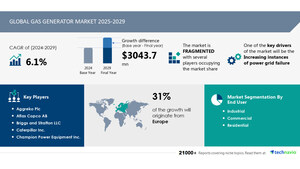NEW YORK, Sept. 9, 2024 /PRNewswire/ -- Report on how AI is driving market transformation- The global waste to energy market size is estimated to grow by USD 28.68 billion from 2024-2028, according to Technavio. The market is estimated to grow at a CAGR of over 7.51% during the forecast period. Increasing awareness about climate change is driving market growth, with a trend towards increased waste generation for waste to energy. However, high operating and maintenance costs of waste to energy plants poses a challenge. Key market players include A2A SpA, Abu Dhabi National Energy Company PJSC, Babcock and Wilcox Enterprises Inc., BlueFire Renewables Inc., China Everbright Environment Group Ltd., China Jinjiang Environment Holding Co. Ltd., CNIM SA, Covanta Holding Corp., Ener Core Inc., Future Biogas Ltd., Hitachi Zosen Corp., John Wood Group PLC, Keppel Corp. Ltd., MARTIN GmbH, Meridiam SAS, Mitsubishi Heavy Industries Ltd., MVV Energie AG, Veolia Environnement SA, Waste Management Inc., and Wheelabrator Technologies Holdings Inc..
Key insights into market evolution with AI-powered analysis. Explore trends, segmentation, and growth drivers- View the snapshot of this report
Waste To Energy Market Scope |
|
Report Coverage |
Details |
Base year |
2023 |
Historic period |
2018 - 2022 |
Forecast period |
2024-2028 |
Growth momentum & CAGR |
Accelerate at a CAGR of 7.51% |
Market growth 2024-2028 |
USD 28689.1 million |
Market structure |
Fragmented |
YoY growth 2022-2023 (%) |
6.53 |
Regional analysis |
Europe, APAC, North America, Middle East and Africa, and South America |
Performing market contribution |
Europe at 43% |
Key countries |
Germany, Japan, China, US, and France |
Key companies profiled |
A2A SpA, Abu Dhabi National Energy Company PJSC, Babcock and Wilcox Enterprises Inc., BlueFire Renewables Inc., China Everbright Environment Group Ltd., China Jinjiang Environment Holding Co. Ltd., CNIM SA, Covanta Holding Corp., Ener Core Inc., Future Biogas Ltd., Hitachi Zosen Corp., John Wood Group PLC, Keppel Corp. Ltd., MARTIN GmbH, Meridiam SAS, Mitsubishi Heavy Industries Ltd., MVV Energie AG, Veolia Environnement SA, Waste Management Inc., and Wheelabrator Technologies Holdings Inc. |
Market Driver
The global waste to energy market is witnessing a significant growth due to the rising trend of waste generation caused by a growing population and urbanization. This increasing waste production calls for sustainable and cost-effective waste management solutions. Waste to energy technologies, such as incineration, gasification, and pyrolysis, are being utilized to convert waste into energy, thereby reducing waste in landfills and decreasing greenhouse gas emissions. Governments and regulatory bodies worldwide are implementing policies and incentives to encourage the development of waste to energy solutions, further fueling market growth. This trend is projected to continue during the forecast period as waste generation persists to increase.
The Waste to Energy market is a growing industry focused on converting waste materials into alternate energy sources. With industrialization and urbanization leading to increased waste generation, there's a pressing need for effective waste management systems. Waste, including municipal solid waste, industrial waste, and agricultural waste, can be transformed into biofuels like biogas, bioethanol, and biomass through technologies such as anaerobic decomposition and incineration thermal. However, this process comes with challenges like carbon emissions, air pollution, and environmental impact on health. Regulations are in place to monitor these issues, but public acceptance remains a concern. Calorific value plays a crucial role in determining the feasibility of waste conversion projects. Waste sorting and treatment facilities are essential for optimizing the conversion process. Technology innovation is key to addressing these challenges and improving the financial viability of Waste to Energy projects. Renewable energy sources like wind and solar are gaining popularity over fossil fuels, but Waste to Energy offers a unique solution to the issue of waste management. By focusing on reducing environmental pollution and ensuring human health, the industry can contribute significantly to a sustainable future.
Request Sample of our comprehensive report now to stay ahead in the AI-driven market evolution!
Market Challenges
- The global waste to energy market faces significant challenges due to the high operating and maintenance costs associated with waste to energy plants. These costs are primarily driven by the complex nature of the facilities, which require specialized equipment and highly skilled operators to handle various types of waste and ensure compliance with environmental regulations. The high capital investment required for construction and operation leads to expensive electricity prices and more costly waste processing compared to traditional disposal methods. The need for advanced technology to monitor and control emissions of pollutants, such as nitrogen oxides and sulfur dioxide, adds to the overall cost of running waste to energy plants. These factors may limit the adoption of efficient waste to energy processes, thereby restricting the growth of the global waste to energy market during the forecast period.
- The Waste to Energy (WtE) market is growing due to increasing urbanization and population, leading to higher waste generation. However, challenges persist in implementing WtE technologies like anaerobic decomposition and thermal conversion. Industrialization and agricultural waste contribute significantly to waste streams, requiring advanced treatment facilities. Air pollution levels are a concern, with regulations on emissions tightening. Human health and environmental impact are key considerations. Financial resources and public acceptance are crucial for project success. Technology innovation, such as gasification and pyrolysis, offers potential solutions. Waste sorting and recycling are essential for operational efficiency and reducing environmental pollution. Regulations and monitoring ensure compliance. Renewable energy sources like WtE offer an alternative to fossil fuels. Calorific value determines the efficiency of conversion. Project capabilities, geographic reach, and waste types, including municipal solid waste and industrial waste, impact market potential. Technology advancements, like improved thermal processes, can enhance efficiency and reduce costs. WtE projects must balance financial resources, environmental impact, and public acceptance to succeed.
Discover how AI is revolutionizing market trends- Get your access now!
Segment Overview
This waste to energy market report extensively covers market segmentation by
- Technology
- 1.1 Thermal
- 1.2 Biological
- Application
- 2.1 Electricity
- 2.2 Heat
- Geography
- 3.1 Europe
- 3.2 APAC
- 3.3 North America
- 3.4 Middle East and Africa
- 3.5 South America
1.1 Thermal- The global waste to energy market utilizes thermal technology to convert waste into usable energy. This technology encompasses incineration, gasification, pyrolysis, and plasma arc gasification. Incineration, the most prevalent method, burns waste at high temperatures to generate steam for electricity. Gasification converts waste into gas through heating in an oxygen-deprived environment, which can be used as fuel or electricity. Pyrolysis heats waste without oxygen to create fuel from the resulting liquid or gas. Plasma arc gasification uses plasma to transform waste into gas, which can function as a fuel. These technologies are employed in various waste to energy facilities, including mass-burn, modular, and refuse-derived fuel plants. Each technology offers distinct advantages and disadvantages, influenced by factors like waste type, plant location, and local waste disposal regulations. These factors will shape the development of the waste to energy market segment during the forecast period.
Download a Sample of our comprehensive report today to discover how AI-driven innovations are reshaping competitive dynamics
Research Analysis
The Waste to Energy (WtE) market represents a significant solution to address the challenges of waste management and energy generation. With industrialization and urbanization leading to increased waste generation and carbon emissions, WtE has emerged as an alternate energy source, converting organic and other waste materials into biofuels such as biogas, biomass, bioethanol, and others. This process not only reduces the amount of waste sent to landfills but also helps decrease air pollution and greenhouse gas emissions. However, it is essential to consider the environmental impact and human health implications of WtE technologies, particularly those using incineration thermal technology. Population growth and increasing waste generation levels necessitate the adoption of effective WtE solutions to mitigate the negative effects on the environment and public health.
Market Research Overview
The Waste to Energy (WtE) market refers to the process of converting waste materials into usable energy through various technologies. This alternate energy source is becoming increasingly important due to industrialization, urbanization, and population growth leading to high levels of waste generation. Waste materials such as municipal solid waste, industrial waste, and agricultural waste undergo conversion processes like incineration thermal technology and anaerobic decomposition technology to produce energy in the form of heat, electricity, or biofuels like biogas, bioethanol, and biomass. However, the environmental impact of WtE must be considered, including carbon emissions and air pollution. Regulations and monitoring are essential to mitigate these impacts and ensure human health and environmental health are protected. Renewable energy sources like WtE are crucial as we move away from fossil fuels, but public acceptance and financial resources are necessary for successful implementation. Waste sorting and treatment facilities are essential components of the waste management system, ensuring the efficient and effective conversion of waste streams into energy. Technology innovation, project capabilities, operational efficiency, and geographic reach are key factors in the success of WtE projects. Other conversion technologies like gasification, pyrolysis, and recycling also play a role in the WtE market.
Table of Contents:
1 Executive Summary
2 Market Landscape
3 Market Sizing
4 Historic Market Size
5 Five Forces Analysis
6 Market Segmentation
- Technology
- Thermal
- Biological
- Application
- Electricity
- Heat
- Geography
- Europe
- APAC
- North America
- Middle East And Africa
- South America
7 Customer Landscape
8 Geographic Landscape
9 Drivers, Challenges, and Trends
10 Company Landscape
11 Company Analysis
12 Appendix
Technavio is a leading global technology research and advisory company. Their research and analysis focuses on emerging market trends and provides actionable insights to help businesses identify market opportunities and develop effective strategies to optimize their market positions.
With over 500 specialized analysts, Technavio's report library consists of more than 17,000 reports and counting, covering 800 technologies, spanning across 50 countries. Their client base consists of enterprises of all sizes, including more than 100 Fortune 500 companies. This growing client base relies on Technavio's comprehensive coverage, extensive research, and actionable market insights to identify opportunities in existing and potential markets and assess their competitive positions within changing market scenarios.
Technavio Research
Jesse Maida
Media & Marketing Executive
US: +1 844 364 1100
UK: +44 203 893 3200
Email: [email protected]
Website: www.technavio.com/
SOURCE Technavio

WANT YOUR COMPANY'S NEWS FEATURED ON PRNEWSWIRE.COM?
Newsrooms &
Influencers
Digital Media
Outlets
Journalists
Opted In






Share this article